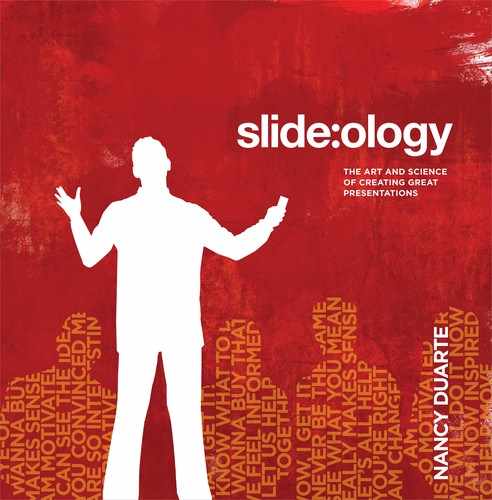224 slide:ology
The ancient Romans used architecture as a mnemonic
device for presentations. They would build a structure
in their mind and memory that triggered ideas to use
in their speech. So as they wandered around in their
mental architecture, they would be reminded of various
concepts and phrases. I do that same thing. I literally
build my speech in my mind with all of its connectivity
to ideas, concepts, and details. And then I use all the
devices of architecture to create the experience of inhab-
iting the stories. So if I’m giving a small speech I’ll design
a baptistery or I’ll think of Martin Luther King and his
church in Atlanta, or Gandhi sitting and spinning cotton.
I focus on one thing that keeps me grounded.
But if I have a big speech, I design a great public building
in my mind. It has forecourts and a grand staircase. I’ll
relate that to the ideas of the storytelling. I’ll realize that
Navigating Through Your Message
An Interview with Bill McDonough
in order for you to understand this great edifice, I need to
take you through a certain series of experiences that are
the preamble to entering the building.
When we enter the building I can take you into a vestibule
where you’ll find yourself in the umbrage. Having come
from the great outdoors, your pupils will dilate and you’ll
try to understand what is going on. In the same way, with
the storytelling, at that point I’ll bring up one of the central
ideas of the story that I want to tell.
But I’ll do this in a way that is obscure; not abstruse per
se but slightly obscured so you’ll wonder what it is I’m
talking about. People become quizzical and curious about
what they’re about to encounter because it’s slightly dark,
veiled and small, yet it’s close and curious. Then I’ll walk
you into the atrium of the building and all of a sudden it’s
The first time I worked with McDonough he described
for my team the journey he takes his audience on. This
method of memorization is sometimes referred to as
the Roman Room.
“
Interacting with Slides 225
as bright as day again. But because your pupils are dilated
it seems brighter than the outdoors, even though it might
be dimmer because you’re actually inside a building. The
big idea—which is now announced—is as bright as all the
great outdoors. And yet you’re inside of the building and
I have you inside the story.
Each of the rooms off of the atrium will be associated
with an idea or a set of ideas. I can wander around the
rooms and I can wander out onto a terrace and look at a
great view. A great big view might remind me of a great
big idea and a geranium in a pot might remind me of
another idea, a little idea. I can wander freely.
When I speak without visual aids, I can wander anywhere
I want, and I know that I’m not going to lose the story
because the story is the building. All I have to do is make
”
(See a case study of Bill McDonough’s work on page 30.)
sure I get through the whole building and then you’ve
seen the whole story. I can choose different routes. I
could decide you’re not ready for the kitchen yet so I’m
taking you to the living room. I can wander around freely
and not lose track of my overall story. When I am using
visual aids, I put them in a specific order, the way a tour
guide would give you a tour of a building. The slides are
in a formatted process.
When we come back out through the atrium you get to
see the big idea once more. We go back out through
the vestibule, so you go back out through the darkness
yet another time. Your curiosity is piqued, then I bring you
back to the great outdoors, out in front of the building. All
of a sudden the brightness is incredibly bright because
now you’re back outdoors again and you see the whole
world in a different way.
..................Content has been hidden....................
You can't read the all page of ebook, please click here login for view all page.
